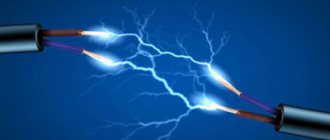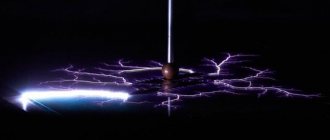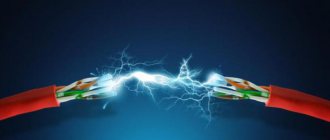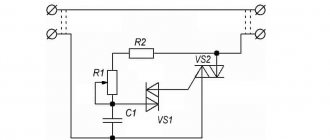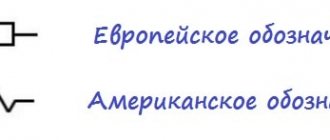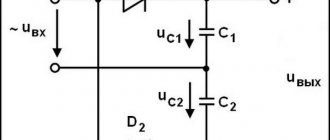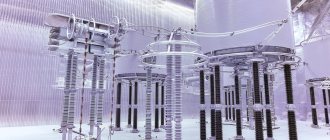In the modern world, every person has been exposed to electricity since childhood. The first mentions of this natural phenomenon date back to the times of the philosophers Aristotle and Thales, who were intrigued by the amazing and mysterious properties of electric current. But it was only in the 17th century that great scientific minds began a series of discoveries concerning electrical energy that continue to this day.
The discovery of electric current and the creation of the world's first generator by Michael Faraday in 1831 radically changed human life. We are accustomed to the fact that our lives are made easier by devices that operate using electrical energy, but most people still do not understand this important phenomenon. To begin, to understand the basic principles of electricity, you need to learn two basic definitions: electric current and voltage.
Electricity
The word “ current ” itself implies movement .
Some bodies (conductors) have free electrons that can carry electrical charge. This charge will be negative, because that’s exactly what electrons have.
Are there any other particles in bodies that can carry a charge? It turns out that there is.
If ordinary atoms are electrically neutral, then ions have some charge. It can be both negative and positive. These particles are larger than electrons, but can also carry electrical charge.
This means that electrons or ions can somehow move in conductors. This is where the definition of electric current follows (Figure 1).
Electric current is the ordered (directed) movement of charged particles.
Figure 1. Movement of charged particles in conductors
Please note that this movement is directed and not random. When we say that a current flows through the body, we mean a certain direction. We will talk about what this direction is in a separate lesson.
Why is electricity so popular?
Now we cannot imagine a normal day without electricity; this type of energy has taken root in our everyday life so well that we simply cannot do anything without it. Just imagine for a moment this horror without electricity, when our entire world will be swallowed up by pitch darkness... It will be impossible to cook food without electricity, TV and the Internet will not be able to work. Go into your kitchen and count the number of electrical appliances, you will probably count at least ten pieces. What if we go back in time, when electrical energy was not so widespread? We somehow managed without her. Yes, but with her appearance our life became much simpler, we had more time and we began to have time to do more things. We are not even talking about industry, what a leap occurred in its development with the advent of this type of energy, new opportunities and technologies opened up, humanity simply soared upward in its development. You may ask, why electricity, why this type of energy, because there are many alternative energy sources? For example, to operate electrical engineering, you can use thermal energy, mechanical energy, solar energy, tidal energy, and so on. But why this particular type of energy? Yes, because its use is economically profitable and efficient, it is easy to obtain and transmit and, most importantly, convert it into other types of energy we need. Another important advantage of all electric machines is their compactness. If we compare an internal combustion engine and a simple electric motor of the same power, then the second one is at least twice as powerful. Not to mention the cost of maintenance, losses and the amount of energy spent on doing the same work.
Receiving Electric Current
Electric current cannot occur on its own. What needs to be created in a conductor for a current to arise and exist in it?
To obtain electric current in a conductor, it is necessary to create an electric field in it.
When an electric field appears, electric forces will also arise. They will set charged particles in motion. This is how electric current arises.
Okay, so we created an electric field, a current appeared. It is logical to assume that if the electric field disappears, then the current will also disappear.
This means that for a longer current to exist, we need to maintain a constant existence of the electric field.
Classification
Direct and alternating current
If charged particles move inside macroscopic bodies relative to a particular medium, then such a current is called electric “conduction current”. If macroscopic charged bodies (for example, charged raindrops) are moving, then this current is called “convection”.
Currents are divided into direct and alternating. There are also all kinds of alternating current. When defining types of current, the word “electric” is omitted.
- Direct current is a current whose direction and magnitude do not change over time. There can be a pulsating, for example a rectified variable, which is unidirectional.
- Alternating current is an electric current that varies over time. Alternating current refers to any current that is not direct.
- Periodic current is an electric current, the instantaneous values of which are repeated at regular intervals in an unchanged sequence.
- Sinusoidal current is a periodic electric current that is a sinusoidal function of time. Among alternating currents, the main one is the current whose value varies according to a sinusoidal law. Any periodic non-sinusoidal current can be represented as a combination of sinusoidal harmonic components (harmonics) having corresponding amplitudes, frequencies and initial phases. In this case, the electrostatic potential of each end of the conductor changes in relation to the potential of the other end of the conductor alternately from positive to negative and vice versa, passing through all intermediate potentials (including zero potential). As a result, a current arises that continuously changes direction: when moving in one direction, it increases, reaching a maximum, called the amplitude value, then decreases, at some point becomes equal to zero, then increases again, but in a different direction and also reaches the maximum value , decreases and then passes through zero again, after which the cycle of all changes resumes.
- Quasi-stationary current is a relatively slowly varying alternating current, for instantaneous values of which the laws of direct currents are satisfied with sufficient accuracy. These laws are Ohm's law, Kirchhoff's rules and others. Quasi-stationary current, like direct current, has the same current strength in all sections of an unbranched circuit. When calculating quasi-stationary current circuits due to the emerging e. d.s. inductions of capacitance and inductance are taken into account as lumped parameters. Ordinary industrial currents are quasi-stationary, except for currents in long-distance transmission lines, in which the condition of quasi-stationary along the line is not satisfied.
- High-frequency current is an alternating current (starting from a frequency of approximately tens of kHz), for which such phenomena become significant that are either useful, determining its use, or harmful, against which the necessary measures are taken, such as radiation of electromagnetic waves and skin effect . In addition, if the wavelength of alternating current radiation becomes comparable to the dimensions of the elements of the electrical circuit, then the quasi-stationary condition is violated, which requires special approaches to the calculation and design of such circuits.
- A pulsating current is a periodic electric current, the average value of which over a period is different from zero.
- Unidirectional current is an electric current that does not change its direction.
Eddy currents
Eddy currents Foucault
Eddy currents (or Foucault currents) are closed electric currents in a massive conductor that arise when the magnetic flux penetrating it changes, therefore eddy currents are induced currents. The faster the magnetic flux changes, the stronger the eddy currents. Eddy currents do not flow along specific paths in wires, but when they close in the conductor, they form vortex-like circuits.
The existence of eddy currents leads to the skin effect, that is, to the fact that alternating electric current and magnetic flux propagate mainly in the surface layer of the conductor. Heating of conductors by eddy currents leads to energy losses, especially in the cores of AC coils. To reduce energy losses due to eddy currents, they use the division of alternating current magnetic circuits into separate plates, isolated from each other and located perpendicular to the direction of the eddy currents, which limits the possible contours of their paths and greatly reduces the magnitude of these currents. At very high frequencies, instead of ferromagnets, magnetodielectrics are used for magnetic circuits, in which, due to the very high resistance, eddy currents practically do not arise.
Sources of electric current
The electric field is created and maintained by sources of electric current .
They can be very different. But they have one thing in common: they separate positively and negatively charged particles .
With this separation, two poles are formed at the current sources. Positive charges accumulate on one, and negative charges on the other. An electric field is created.
As a result, one pole of the current source will always be positively charged, and the other negatively.
The conductor is connected to these poles using special terminals or clamps. Under the influence of the electric field of the current source, free charged particles in the conductor begin to move. This is how electric current arises.
Using a simple set of objects, you can create your own source of electric current. Albeit weak, but still. For example, even an ordinary lemon will do for this (Figure 2).
Figure 2. Current source from lemon
For this we need two rods: iron and copper. Let's stick them into the lemon and connect them with a conductor. An electric current will arise in it.
This means that the lemon juice enters into chemical bonds with the plates, causing charge separation. By connecting a device to measure current characteristics to this system, we only make sure that we have created a current source from scrap materials.
Electrical capacity and capacitor
Electrical capacity
– a quantitative measure of a conductor’s ability to hold a charge.
The simplest methods of separating unlike electric charges - electrification and electrostatic induction - allow one to obtain a small amount of free electric charges on the surface of bodies. To accumulate significant quantities of opposite electrical charges, capacitors
.
Capacitor
is a system of two conductors (plates) separated by a dielectric layer, the thickness of which is small compared to the size of the conductors.
For example, two flat metal plates arranged in parallel and separated by a dielectric layer form a flat
capacitor.
If the plates of a flat capacitor are given charges of equal magnitude and opposite signs, then the electric field strength between the plates will be twice as strong as the field strength of one plate. Outside the plates, the electric field strength is zero, since equal charges of opposite signs on two plates create electric fields outside the plates, the strengths of which are equal in magnitude but opposite in direction.
Conversion of mechanical energy into electrical energy
To separate charged particles in a device that will become a current source, you need to do some work . During this work, some energy is converted into electrical energy.
But energy cannot come out of nowhere. This means that the current source itself requires some kind of energy.
For example, at a hydroelectric power station, the mechanical energy of water flow is converted into electricity (Figure 3).
Figure 3. Conversion of mechanical energy of water flow into electrical energy
A dam and reservoir are being built. Water from it flows downwards under the influence of gravity. Thus, it rotates the hydraulic turbine. A device such as an electric generator is connected to the hydraulic turbine (more about it at the end of the lesson). Electrical energy already comes out of it. Current flows through the wires and enters our home.
Let's look at another example in which mechanical energy is converted into electrical energy.
This happens in a device called an electrophore machine (Figure 4).
It consists of two plastic disks 1 . There is a short distance between them. By rotating the handle located on the back surface of the machine, we will set two disks in motion. They will rotate in different directions.
Figure 4. Electrophore machine
As a result, they become electrified due to friction against that small air gap between them. Charges accumulate in Leyden jars 2 . From there they are transmitted to conductors 3 .
As a result, a positive charge is formed on one conductor, and a negative charge on the other. At some point, as they approach, a short-term current appears in the form of an electrical discharge, which looks like a small lightning bolt.
So the mechanical energy of rotating the handle of the machine turned into electrical energy .
History of the discovery of electricity
To begin with, it must be said that there is no such scientist who can be considered the discoverer of electricity, since from ancient times to the present day, many scientists have been studying its properties and learning something new about electricity.
- The first person to become interested in electricity was the ancient Greek philosopher Thales. He discovered that amber, which is rubbed on wool, acquires the property of attracting other light bodies.
- Then another ancient Greek scientist, Aristotle, studied certain eels that struck enemies, as we now know, with an electric discharge.
- In 70 AD, the Roman writer Pliny studied the electrical properties of resin.
- However, then for a long time no knowledge was gained about electricity.
- And only in the 16th century, the court physician of the English Queen Elizabeth 1, William Gilbert, began studying electrical properties and made a number of interesting discoveries. After this, literally “electrical madness” began.
- Only in 1600 did the term “electricity” appear, introduced by the English scientist William Gilbert.
- In 1650, thanks to the burgomaster of Magdeburg, Otto von Guericke, who invented an electrostatic machine, it became possible to observe the effect of repulsion of bodies under the influence of electricity.
- In 1729, the English scientist Stephen Gray, while conducting experiments on transmitting electric current over a distance, accidentally discovered that not all materials have the ability to transmit electricity equally.
- In 1733, the French scientist Charles Dufay discovered the existence of two types of electricity, which he called glass and resin. They received these names due to the fact that they were revealed by rubbing glass on silk and resin on wool.
- The first capacitor, that is, an electricity storage device, was invented by the Dutchman Pieter van Musschenbroek in 1745. This capacitor was called the Leyden jar.
- In 1747, the American B. Franklin created the world's first theory of electricity. According to Franklin, electricity is an immaterial liquid or liquid. Another of Franklin's services to science is that he invented the lightning rod and, with the help of it, proved that lightning has an electrical origin. He also introduced the concepts of positive and negative charges, but did not discover charges. This discovery was made by the scientist Simmer, who proved the existence of charge poles: positive and negative.
- The study of the properties of electricity moved to the exact sciences after in 1785 Coulomb discovered the law about the interaction force occurring between point electric charges, which was called Coulomb's Law.
- Then, in 1791, the Italian scientist Galvani published a treatise stating that an electric current arises in the muscles of animals when they move.
- The invention of the battery by another Italian scientist, Volta, in 1800, led to the rapid development of the science of electricity and a subsequent series of important discoveries in this field.
- This was followed by the discoveries of Faraday, Maxwell and Ampere, which occurred in just 20 years.
- In 1874, Russian engineer A.N. Lodygin received a patent for an incandescent lamp with a carbon rod, invented in 1872. Then the lamp began to use a tungsten rod. And in 1906, he sold his patent to Thomas Edison's company.
- In 1888, Hertz recorded electromagnetic waves.
- In 1879, Joseph Thomson discovered the electron, which is the material carrier of electricity.
- In 1911, the Frenchman Georges Claude invented the world's first neon lamp.
- The twentieth century gave the world the theory of Quantum Electrodynamics.
- In 1967, another step was taken towards studying the properties of electricity. This year the theory of electroweak interactions was created.
However, these are only the main discoveries made by scientists that contributed to the use of electricity. But research continues today, and discoveries in the field of electricity occur every year.
Everyone is sure that the greatest and most powerful in terms of discoveries related to electricity was Nikola Tesla. He himself was born in the Austrian Empire, now the territory of Croatia. His baggage of inventions and scientific works includes: alternating current, field theory, ether, radio, resonance and much more. Some admit the possibility that the phenomenon of the “Tunguska meteorite” is nothing more than the work of Nikola Tesla himself, namely an explosion of enormous power in Siberia.
Nikola Tesla
Lord of the World - Nikola Tesla
Electricity in nature
For some time it was believed that electricity did not exist in nature. However, after B. Franklin established that lightning has an electrical origin, this opinion ceased to exist.
The importance of electricity in nature, as well as in human life, is quite enormous. After all, it was lightning that led to the synthesis of amino acids and, consequently, to the emergence of life on earth.
Processes in the nervous system of humans and animals, such as movement and breathing, occur due to nerve impulses that arise from electricity existing in the tissues of living beings.
Electricity in nature
Some types of fish use electricity, or rather electrical discharges, to protect themselves from enemies, search for food under water and obtain it. Such fish are: eels, lampreys, electric rays and even some sharks. All these fish have a special electrical organ that works on the principle of a capacitor, that is, it accumulates a fairly large electrical charge and then discharges it onto the victim who touches such a fish. Also, such an organ operates with a frequency of several hundred hertz and has a voltage of several volts. The current strength of the electric organ of fish changes with age: the older the fish becomes, the greater the current strength. Also, thanks to electric current, fish that live at great depths navigate in the water. The electric field is distorted by the action of objects in the water. And these distortions help fish navigate.
Solar power plant
Deadly experiments. Electricity
Getting electricity
Power plants were specially created to generate electricity. At power plants, with the help of generators, electricity is created, which is then transmitted to places of consumption via power lines. Electric current is created due to the conversion of mechanical or internal energy into electrical energy. Power plants are divided into: hydroelectric power plants or HPPs, thermal nuclear, wind, tidal, solar and other power plants.
In hydroelectric power plants, generator turbines driven by the flow of water produce electric current. In thermal power plants or, in other words, thermal power plants, electric current is also generated, but instead of water, water vapor is used, which arises during the heating of water during the combustion of fuel, for example, coal.
What is electricity - about the nature of electricity - I.P. Kopylov - Yu.N. Ivanov - Global Wave
A very similar operating principle is used in a nuclear power plant or nuclear power plant. Only nuclear power plants use a different type of fuel - radioactive materials, for example, uranium or plutonium. Their nuclei fission, resulting in the release of a very large amount of heat, which is used to heat the water and turn it into water vapor, which then enters a turbine that generates electric current. Such stations require very little fuel to operate. So ten grams of uranium generates the same amount of electricity as a car of coal.
Why is there 220 volts in the outlet?
Use of electricity
Nowadays, life without electricity is becoming impossible. It has become quite integrated into the lives of people in the twenty-first century. Electricity is often used for lighting, for example using an electric or neon lamp, and for transmitting all kinds of information using telephone, television and radio, and in the past, telegraph. Also, back in the twentieth century, a new area of application of electricity appeared: a power source for electric motors of trams, subway trains, trolleybuses and electric trains. Electricity is necessary for the operation of various household appliances, which significantly improve the life of a modern person.
Today, electricity is also used to produce quality materials and process them. Electric guitars, powered by electricity, can be used to create music. Electricity also continues to be used as a humane method of killing criminals (the electric chair) in countries that allow the death penalty.
Also, considering that the life of a modern person is becoming almost impossible without computers and cell phones, which require electricity to operate, the importance of electricity will be quite difficult to overestimate.
Electricity in mythology and art
In the mythology of almost all nations there are gods who are capable of throwing lightning, that is, who can use electricity. For example, among the Greeks this god was Zeus, among the Hindus it was Agni, who could turn into lightning, among the Slavs it was Perun, and among the Scandinavian peoples it was Thor.
Cartoons also have electricity. So in the Disney cartoon Black Cape there is an anti-hero Megavolt, who is able to control electricity. In Japanese animation, electricity is wielded by the Pokemon Pikachu.
Conversion of internal energy into electrical energy
Now let's consider the transformation of internal energy into electrical energy. To do this, take two wires and solder them to each other. And then we heat this junction (Figure 5).
Figure 5. Conversion of internal energy into electrical energy
As a result of this heating, an electric current will arise in the wire. The device connected to our wire is called a galvanometer. We will look at the principle of its operation later, but for now we will use this device to determine the presence of electric current in a conductor. The arrow deviates - there is current, the arrow remains in place - there is no current.
Such a current source, consisting of a heater and the junction of wires made of different metals, is called a thermoelement .
In thermoelements, internal energy is converted into electrical energy.
Symbols on electrical devices and diagrams
Often there is a need to determine at what current a device operates. After all, connecting a device operating on direct current to an alternating current electrical network will inevitably lead to unpleasant consequences: damage to the device, fire, electric shock. For this purpose, there are generally accepted symbols in the world for such systems and even color marking of wires.
Conventionally, on electrical appliances operating on direct current, one line, two solid lines, or a solid line together with a dotted line, located one below the other, are indicated. Also, such a current is marked with the Latin letters DC . The electrical insulation of wires in DC systems is colored red for the positive wire and blue or black for the negative wire.
Conversion of radiation energy into electrical energy
Let's consider another interesting transformation of energies. Let's take a plate of silicon (or copper oxide, selenium). Let's point the switched-on lamp at it (Figure 6).
Figure 6. Conversion of radiation energy into electrical energy
Again we will see that current flows through the conductor. In this case, the plate loses its negative electrical charge and loses electrons.
This is how radiation energy (light from a lamp) turns into electrical energy. This phenomenon is called photoelectric effect , and such a current source is called a photocell .
You will study thermocouples and photocells in more detail in high school.
Current and voltage. Types and rules. Operation and characteristics
Current and voltage are quantitative parameters used in electrical circuits. Most often, these quantities change over time, otherwise there would be no point in the operation of the electrical circuit.
Voltage
Conventionally, voltage is denoted by the letter “U”. The work expended in moving a unit of charge from a point of low potential to a point of high potential is the voltage between those two points. In other words, it is the energy released after a unit of charge moves from high to low potential.
Voltage can also be called potential difference, as well as electromotive force. This parameter is measured in volts. To move 1 coulomb of charge between two points that have a voltage of 1 volt, 1 joule of work must be done. Coulombs measure electrical charges. 1 coulomb is equal to the charge of 6x10 18 electrons.
Voltage is divided into several types, depending on the types of current:
- Constant pressure. It is present in electrostatic and direct current circuits.
- AC voltage. This type of voltage is found in circuits with sinusoidal and alternating currents. In the case of a sinusoidal current, the following voltage characteristics are considered: - the amplitude of voltage fluctuations is its maximum deviation from the abscissa axis; - instantaneous stress, which is expressed at a certain point in time; — effective voltage, determined by the active work performed in the 1st half-cycle; - average rectified voltage, determined by the absolute value of the rectified voltage over one harmonic period.
When transmitting electricity through overhead lines, the design of supports and their dimensions depend on the magnitude of the applied voltage. The voltage between phases is called line voltage, and the voltage between ground and each phase is called phase voltage. This rule applies to all types of overhead lines. In Russia, in household electrical networks, the standard is three-phase voltage with a linear voltage of 380 volts and a phase voltage of 220 volts.
Electricity
Current in an electrical circuit is the speed of movement of electrons at a certain point, measured in amperes, and denoted in diagrams by the letter “ I ”. Derived units of ampere with the corresponding prefixes milli-, micro-, nano, etc. are also used. A current of 1 ampere is generated by moving a unit of charge of 1 coulomb in 1 second.
It is conventionally considered that the current in an electrical circuit flows in the direction from positive potential to negative. However, from the physics course we know that the electron moves in the opposite direction.
You need to know that voltage is measured between 2 points on the circuit, and current flows through one specific point in the circuit, or through its element. Therefore, if someone uses the expression “tension in resistance,” then this is incorrect and illiterate. But often we are talking about voltage at a certain point in the circuit. This refers to the voltage between the ground and this point.
Voltage is generated by exposure to electrical charges in generators, batteries, solar cells and other devices. Current is created by applying a voltage to two points on a circuit.
To understand what current and voltage are, it would be better to use an oscilloscope. On it you can see the current and voltage, which change their values over time. In practice, the elements of an electrical circuit are connected by conductors. At certain points, the elements of the circuit have their own voltage value.
Current and voltage obey the rules:
- The sum of currents entering a point is equal to the sum of currents leaving the point (charge conservation rule). This rule is Kirchhoff's law for current. The point of entry and exit of the current in this case is called a node. A corollary of this law is the following statement: in a series electrical circuit of a group of elements, the current value is the same for all points.
- In a parallel circuit of elements, the voltage across all elements is the same. In other words, the sum of the voltage drops in a closed circuit is zero. This Kirchhoff law applies to stresses.
- The work performed per unit time by the circuit (power) is expressed as follows: P = U*I . Power is measured in watts. 1 joule of work done in 1 second is equal to 1 watt. Power is distributed in the form of heat, spent on performing mechanical work (in electric motors), converted into radiation of various types, and accumulated in containers or batteries. When designing complex electrical systems, one of the challenges is the thermal load of the system.
Galvanic cell
One of the most common sources of current is a galvanic cell . We will use it in various experiments. Therefore, we will look at it in more detail.
What is a galvanic cell in simple words? This is a well-known battery to all of us.
Let's take a look inside it (Figure 7) to figure out how it works.
Figure 7. Galvanic cell
This element is basically (Figure 7, b) a zinc body 2 , inside of which there is a carbon rod 3 . At the upper end of this rod there is a metal cover 1 .
The rod is surrounded by a mixture of 4 manganese (IV) oxide $MnO_2$ and crushed carbon $C$. Between this mixture and the body itself there is a jelly-like solution of salt 5 (ammonium chloride $NH_4Cl$).
What's the point? The fact is that the zinc $Zn$, which the body is made of, interacts with ammonium chloride $NH_4Cl$. A chemical reaction is taking place. The zinc vessel acquires a negative charge.
But manganese oxide has a positive charge . The carbon rod transfers it to the metal lid.
So, we have a negatively charged body and a positively charged rod. These will be called electrodes . An electric field arises between them.
The very concept of an electrode is synonymous with the concept of a pole. “Electrode” is more often used when describing electrical phenomena and devices, while “pole” is more often used when talking about magnets.
Let's connect these two electrodes with a conductor. Electric current will flow through it. This is how the energy of chemical reactions is converted into electrical energy .
Battery
Another extremely popular power source is a battery . It is the same battery, only now it can be recharged many times (Figure 8, a).
How does the battery work? Its simplest version consists of two lead plates placed in a solution of sulfuric acid (Figure 8, b). The plates will be electrodes creating an electric field.
Figure 8. Battery
But initially the battery does not create any field. It needs to be charged. To do this, take another current source, connect it to the battery and pass current through it.
During such charging, chemical reactions . One electrode (plate) becomes positively charged and the other negatively charged.
Now the battery itself becomes a source of current. It has two poles, designated plus (+) and minus (-).
Remember that when charging the battery, it is important to maintain the correct connection to another power source. The positive pole of the battery should be connected to the positive pole of the current source, and the negative pole to the negative pole.
The battery we examined is called lead (based on the material of the plates) or acid (based on the name of the liquid that fills it).
Along with acid batteries, alkaline (or nickel ) batteries are also widely used. You might think that in such a device two plates would be made of nickel, but in fact only one is made of nickel. The second is made from pressed iron powder.
There are also other types of batteries: lithium-ion, lithium-polymer, gel batteries, nickel-metal hybrid.
Battery Applications
The use of batteries is so widespread that even now, while studying this lesson, you are using batteries. They are in our phones, computers, tablets.
Most modes of transport also rely on batteries. The car engine will not start if the battery under the hood is discharged. Batteries power construction equipment, agricultural equipment, and even airplanes. Modern electric vehicles have a powerful battery at their very core.
Batteries play a big role in emergency situations: they can keep other electrical devices running long enough to resolve problems.
Types of chargers
If batteries require charging, then there are special devices with which this can be done - chargers.
They are classified according to many parameters.
By charging method:
- Constant current Provides fast charging, but causes batteries to wear out faster
- With constant voltage Slower charging, but safer for the battery
- Mixed type They combine the two types above, therefore they are the best option. Can increase battery capacity and extend its service life
By method of use:
- External
- Built-in
Depending on compatibility with other energy source:
- Network Designed for connection to standard 220 V or 380 V networks, i.e. they require a simple connection to an outlet
- Rechargeable They have their own energy storage. Used as a backup drive, allowing you to charge other devices when there is no access to the network
- Car Connected via the cigarette lighter. With their help, you can charge your phone, camera and other equipment in the car.
- Wireless Does not require a cable connection, transmits energy without direct physical contact between the battery and the source
- Universal Combines from several to all of the listed types of chargers
electrical safety
Warning on electrical safety
Includes legal, socio-economic, organizational and technical, sanitary and hygienic, treatment and preventive, rehabilitation and other measures. Electrical safety rules are regulated by legal and technical documents, regulatory and technical framework. Knowledge of the basics of electrical safety is mandatory for personnel servicing electrical installations and electrical equipment. The human body is a conductor of electric current. Human resistance with dry and intact skin ranges from 3 to 100 kOhm.
A current passed through a human or animal body produces the following effects:
- thermal (burns, heating and damage to blood vessels);
- electrolytic (decomposition of blood, disruption of physical and chemical composition);
- biological (irritation and excitation of body tissues, convulsions)
- mechanical (rupture of blood vessels under the influence of steam pressure obtained by heating by the blood flow)
The main factor determining the outcome of electric shock is the amount of current passing through the human body. According to safety precautions, electric current is classified as follows:
- “safe” is considered to be a current whose long-term passage through the human body does not cause harm to it and does not cause any sensations; its value does not exceed 50 μA (alternating current 50 Hz) and 100 μA direct current;
- The “minimum perceptible” alternating current for humans is about 0.6–1.5 mA (alternating current 50 Hz) and 5–7 mA for direct current;
- threshold “non-releasing” is the minimum current of such strength that a person is no longer able to tear his hands away from the current-carrying part by force of will. For alternating current this is about 10-15 mA, for direct current - 50-80 mA;
- The “fibrillation threshold” is an alternating current (50 Hz) strength of about 100 mA and a direct current of 300 mA, the impact of which for more than 0.5 s is likely to cause fibrillation of the heart muscles. This threshold is also considered conditionally fatal for humans.
In Russia, in accordance with the Rules for the technical operation of electrical installations of consumers (Order of the Ministry of Energy of the Russian Federation dated January 13, 2003 No. 6 “On approval of the Rules for the technical operation of electrical installations of consumers”) and the Rules for labor protection during the operation of electrical installations (Order of the Ministry of Energy of the Russian Federation dated December 27, 2000 N 163 “On approval of Interindustry Rules on Labor Protection (Safety Rules) for the Operation of Electrical Installations"), 5 qualification groups for electrical safety were established depending on the qualifications and experience of the employee and the voltage of electrical installations.
Generators
You can generate electric current using a special device - a generator .
Generators convert mechanical energy into electrical energy, sometimes in quite complex ways.
They are used in all vehicles to generate electricity when the vehicle is moving. This energy is also used to charge the battery.
Generators are located at power plants, hydroelectric power plants, and nuclear power plants. Generators are used to generate electricity. There are even geothermal power plants that have electric current generators. In such places, saturated steam from a drilled well is directed to steam turbines connected to generators. So the internal energy of the steam turns into mechanical energy, and then into electrical energy.
Where is it used and what are the advantages of AC and DC current?
Various tasks may require the use of both AC and DC power. Each type of current has its own disadvantages and advantages.
Alternating current is most often used when there is a need to transmit current over long distances. It is more expedient to transmit such current from the point of view of possible losses and the cost of equipment. That is why most electrical appliances and mechanisms use only this type of current.
Residential buildings and enterprises, infrastructure and transport facilities are located at a distance from power plants, so all electrical networks are alternating current. Such networks power all household appliances, industrial equipment, and train locomotives. There are an incredible number of devices operating on alternating current, and it is much easier to describe those devices that use direct current.
Direct current is used in autonomous systems, such as on-board systems in cars, aircraft, ships or electric trains. It is widely used in powering microcircuits of various electronics, in communications and other equipment where it is necessary to minimize the amount of interference and ripple or eliminate them completely. In some cases, such current is used in electric welding work using inverters. There are even railway locomotives that run on DC systems. In medicine, this current is used to introduce drugs into the body using electrophoresis, and for scientific purposes to separate various substances (protein electrophoresis, etc.).
